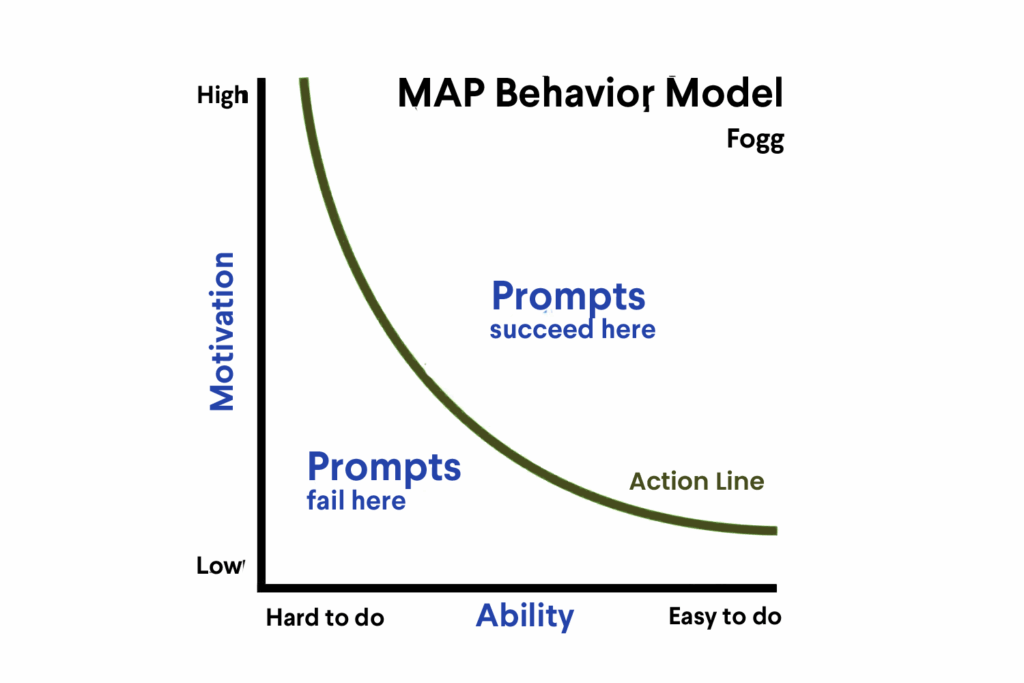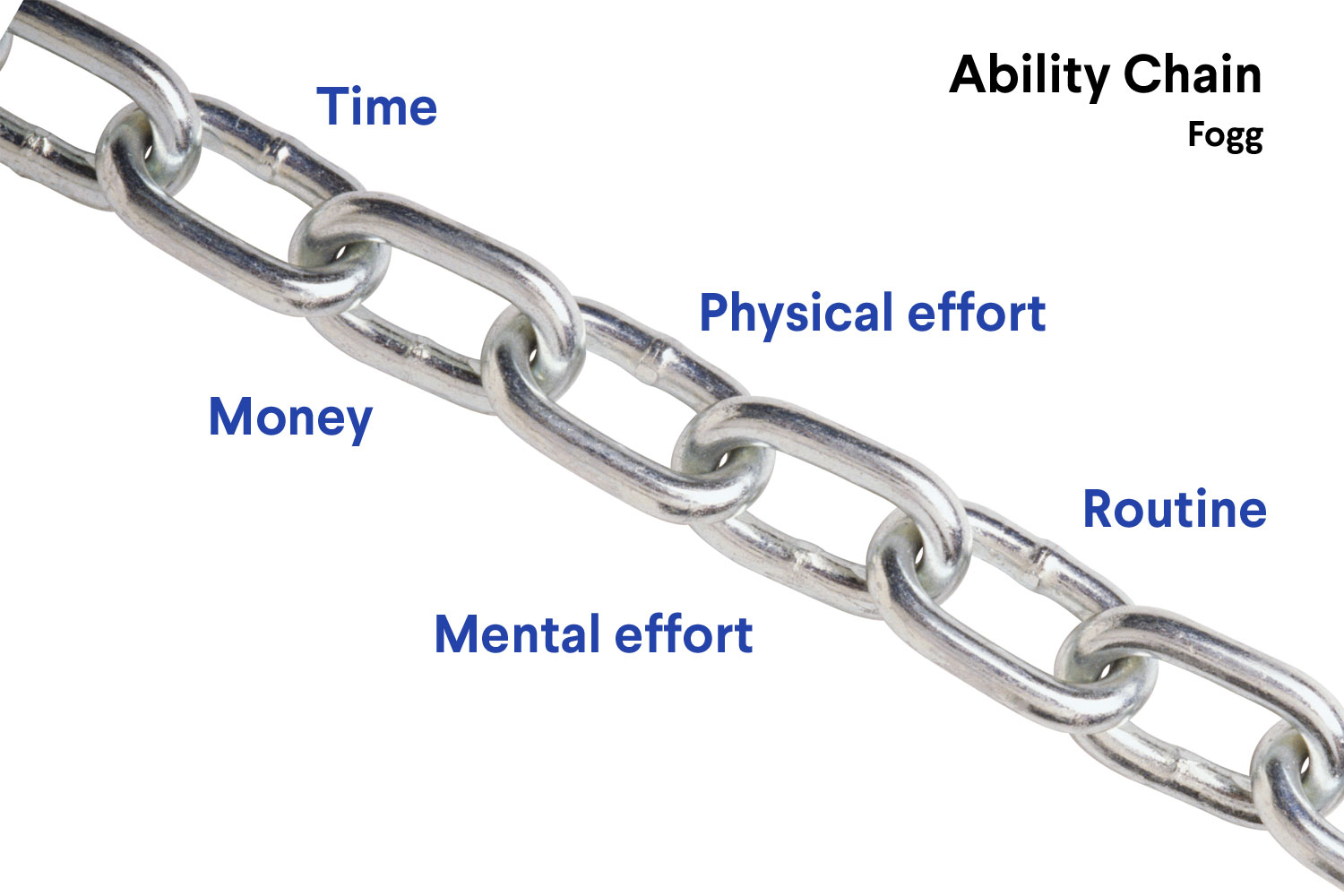The Tiny habits: how small actions make big changes
Change is hard – we all know that. Yet Dr. B.J. Fogg proves that you don’t necessarily have to become a willpower machine to make lasting progress. His method revolves around one simple truth: great results often come from very small, repeated actions. In this article we summarize the key ideas from the book Tiny Habits and provide practical tools to apply them directly to your team. In his book, Fogg frequently uses examples around healthy behavior, but it is also very applicable within teams and organizations. We go into that a little more specifically in the last section.
The core: the Fogg Behavior Model (MAP)
Every action occurs when these three elements are present simultaneously: Motivation (motivation), Ability (capability/simplicity) and a Prompt (cue/trigger). Fogg summarizes this in the acronym MAP: without one of the three, no behavior results. That insight changes the way you approach change: stop accusing yourself of lacking willpower and start analyzing behavior.
Practically, this means: if you want to get someone (or yourself) to adopt new behaviors, first examine what element is missing – is there no prompt? Is the task too difficult? Or is motivation temporarily very low? Often you can influence behavior by simply adjusting one variable.
1) Motivation: not the weak link, but not a lifeline either
Motivation is important, but unreliable. Fogg compares it to a “party-animal friend”: great for one night, but not a reliable partner for daily routines. People often overestimate their future motivation – they devise ambitious plans but quickly become disengaged when the motivation “wave” subsides. That’s why Fogg advises: make your aspirations concrete and look for behaviors that do suit you – the so-called Golden Behaviors.
A practical application: formulate your ambition (e.g., “sleep better”) and think of 5 concrete behaviors that contribute to it. Use a simple focus-map to choose what is doable and meaningful.
2) Ability: make it so easy that it comes naturally
The crucial idea is: simplicity changes behavior. By making a behavior small and easy, you increase the likelihood that it will happen – even if motivation is low. Fogg recommends three ways to make something easier:
- Increase skills (train, learn).
- Provide tools and resources.
- Make the behavior tiny (e.g., one push-up instead of 30).
Concrete technique: dissect the task(Ability Chain) and remove steps or frictions. Even on bad days: do one mini variation. This keeps the habit alive and grows on its own later.
3) Prompts: the invisible drivers
No prompt = no behavior. There are 3 types of prompts (or “triggers”):
- Person prompts: internal (personal) signals (such as hunger). These are often unreliable.
- Context prompts: environmental reminders (notifications, sticky notes).
- Action prompts (anchors): behavior anchors that you use as triggers (e.g., brushing teeth → stretching for 1 minute).
Fogg especially advocates Action Prompts (anchoring): link the new mini-behavior to something (a behavioral anchor) that you already do routinely. A Tiny Habit recipe looks like this: “After I do [existing behavior], I do [small new action].” Example: “After brushing my teeth, I do one simple breathing exercise.”
Tiny Habit recipe: concrete and short
Use this simple formula:
After I [behavior anchor], I will [tiny habit].
Make sure:
- the anchor is reliable (happens daily at the same place/time),
- the new action is really small (takes <30 seconds),
- you immediately add a small celebration (more on that below).
The power of celebration: emotions make habits
A distinguishing point in Fogg’s method is the importance of celebration. Not rewards in the distant future, but immediate feelings of success – Fogg calls it Shine. Celebrations (a little “yes!”, a high-five with yourself, a brief smile) activate the reward system and link a positive emotion to the new action. Emotion speeds up implanting the behavior in your brain: you learn faster and it feels good to keep going.
Tip: experiment with different forms of celebration until you find something that works for you – loud “Victory!”, a small fist bump, or even a quiet “well done” in thought. It’s all about the immediate, positive experience.
From tiny to transformative: grow and multiply
Tiny habits are rarely ends in themselves – they act as seeds. Over time, some tiny habits grow in frequency or intensity (e.g., from 1 push-up to 10), and may even spark new habits (ripple effect). Key principles: start small, observe, celebrate progression and only add something when the original habit feels stable.
Practical application: choose 1-3 tiny habits, keep them up for 7-14 days, evaluate, then slowly scale up. Document successes – this reinforces identity: you begin to see yourself as someone who does change.
Undoing bad habits: tackling them in stages
Fogg provides a clear plan for addressing undesirable behavior:
- Create new positive habits first – that builds skills and success momentum.
- Design specific stops – remove prompts (triggers) or make the unwanted behavior more difficult (more time, cost or effort).
- Swap when quitting fails – replace the bad behavior with something that serves the same need but is healthier.
Example: instead of eliminating sugar completely right away (high risk of failure), first build in small healthy snacks and celebrate each day without a sugar snack. Then make sweets harder to reach or increase the “cost” (e.g. snack no longer in sight).
How the tiny habits method works in teams and organizations
Tiny Habits is not only applicable individually – you can also use it with teams:
- Collective aspirations: define together what success means.
- Golden Behaviors for the team: choose simple behaviors that everyone is willing and able to do.
- Anchors in your workflow: link new routines to existing team rituals (e.g., after each sprint review: 1-minute retrospective action).
- Celebrate together: visible celebrations (shoutouts, micro-ceremonies) quickly reinforce desired behaviors.
A Golden Behavior, according to Fogg, is concrete behavior that simultaneously has three characteristics:
- It fits the motivation and abilities of the target group (people can and want to do it).
- It has great impact on the desired outcome or goal.
- It is a specific, clearly defined behavior (not a vague intention).
Practical checklist to get started today (for individuals and teams)
- Choose one ambition (clear and concrete).
- Think of five possible behaviors – select 1 Golden Behavior: an achievable, attractive and impactful habit that makes a difference.
- Make it tiny – design a mini-action of ≤30 seconds.
- Link to an anchor: choose a reliable existing behavioral anchor as the trigger. Use the recipe: “After I [anchor], I do [tiny habit].”
- Celebrate immediately: find your Shine and use it immediately after the action.
- Log & evaluate after 7-14 days: scale up or adjust.
Common pitfalls – and how to avoid them
- Starting too big: starting out ambitious often leads to procrastination or reeling – make it smaller.
- Wrong prompts: a bad trigger is unreliable; test anchors and context prompts.
- No celebration: don’t forget the emotion – it makes or breaks the learning process.
- Expect motivation to control everything: motivation fluctuates; design for skill and prompts.
Getting Started
Tiny Habits changes how you look at change: not as a struggle against yourself, but as a design challenge. By decomposing behavior into motivation, capability and prompts, you can experiment smarter. Start small, design with compassion, celebrate progress and scale up organically. Whether you have personal goals or want to organize change within teams: the question is not whether small actions work, but how quickly you will design and implement them.
Book: Tiny Habits Small changes, big results
This article is based on the New York Times Bestseller “Tiny Habits” by habit specialistBJ Fogg (Stanford University).
Based on twenty years of research and the guidance of more than 40,000 people, Fogg shows you how to design habits that really stick. Instead of focusing on failure, learn to celebrate and build on moments of success.
Whether you want to sleep better, reduce stress, lose weight or be more productive: with Tiny Habits, you’ll achieve it by starting small.



